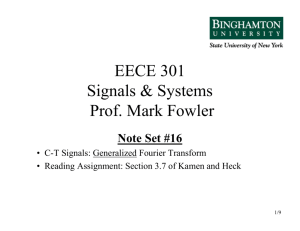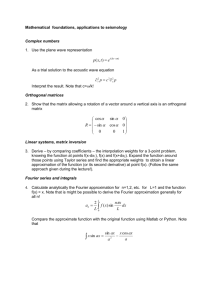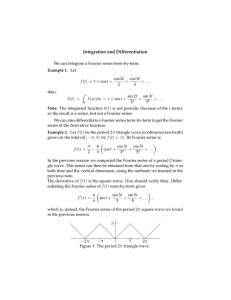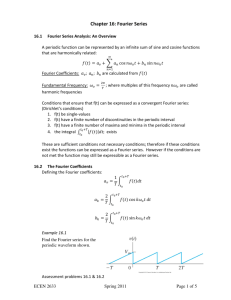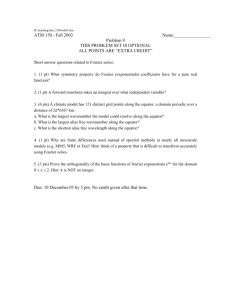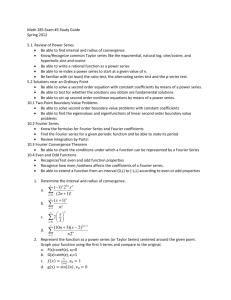Electrical Circuits II (ECE233b) Fourier Analysis Techniques (Part 1)
advertisement
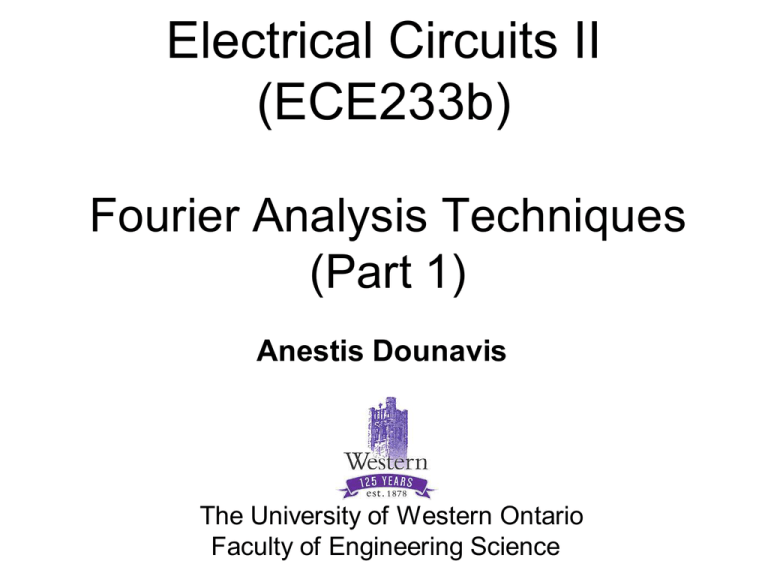
Electrical Circuits II (ECE233b) Fourier Analysis Techniques (Part 1) Anestis Dounavis The University of Western Ontario Faculty of Engineering Science Background We have discussed the following solution methodologies Phasor transforms Steady state; Sinusoidal analysis Laplace transforms Transient and steady state; Any type of forcing function Fourier analysis techniques Fourier transforms Steady state; non-sinusoidal but periodic signals. The periodic signal is expresses as a summation of sinusoids with harmonically related frequencies. Fourier Series A periodic function satisfies the following relationship f(t) f(t nT0 ) n 1,2,3,...... Can be expressed as f(t) a0 Dn cos(n0 t n ) (phasor notation) n 1 where T0 is the period 0 is the fundamental frequency (rad/s) 0=2/T0 Examples of periodic signals sawtooth waveform f(t) f(t) A square waveform A T0 2T0 3T0 t T0 2T0 3T0 t Fourier Series Fourier series can be expressed in the following forms Exponential Fourier Series f(t) a0 cn e n jn ω0t cn e jnω0 t n n 0 Trigonometric Fourier Series f(t) a0 (an cos(n0 t) bn sin(n0 t)) n 1 where n is an integer a0, an, bn and cn are the Fourier coefficients 20, 30, …. , n0 are the harmonic frequencies 0 is the fundamental frequency The two forms are similar since e j cos j sin Fourier Series Relationship between exponential and trigonometric form f(t) a0 c e n n 0 n a 0 cn e n 1 jn ω0t a 0 cn e n 1 jnω0 t c e a0 Re(2c ne * n jnω 0t - jn ω0t n 1 ) a0 Re((Dn n )e jn ω0t ) a0 Re((an - jbn )e n 1 cn e jnω0t where Dn n 2c n an jbn ) a0 (an cos(n0 t) bn sin(n0 t)) n 1 jnω0t * = complex conjugate n 1 n 1 jnω0 t Fourier Series Approximating a square wave 1 sin 2t sin 3 * 2t 3 1 sin 3 * 2t 3 sin 2t Fourier Series Approximating a square wave 8 1 (2 n 1) sin ( 2n 1) * 2t n 1 Fourier Series Determining the coefficients for exponential Fourier series Any physical realizable periodic signal may be represented over the interval t1<t<t1+T0 f(t) cn e jnω0 t by the exponential Fourier series n Multiplying both sides by e-jk t and integrating over the interval t1 to t1+T0 yields 0 t 1 T 0 t 1 T0 t1 t1 - jkω0 t f(t)e dt t 1 T 0 since e t1 - j(n - k)ω 0t jn ω0t - jkω 0t dt c kT0 cn e e n 0 dt T0 for n k for n k The Fourier coefficients are defined as 1 cn T0 t1 T 0 - jn ω0t f(t)e dt t1 Fourier Series Strategy to determine Fourier Coefficients 1. Identify T, 0 and defining equation of function 2. Determine coefficient by appropriate integration Example 1 Determine the exponential Fourier series for the periodic voltage waveform shown v(t) V -T/4 T/4 -T/2 T/2 -V Fourier Series Determining the coefficients for trigonometric Fourier series f(t) a0 (an cos(n0 t) bn sin(n0 t)) n 1 Using the result obtained for the exponential Fourier series 1 cn T0 t1 T 0 f(t)e - jn ω0t -jn0 t e cos(n0 t ) j sin(n0 t ) and 2c n an jbn dt t1 yields the following Fourier coefficients for a0, an and bn 2 an T0 t 1 T0 1 a0 T0 f(t)cos(n ω t)dt 0 t1 t 1 T 0 f(t)dt t1 2 bn T0 t 1 T0 f(t)sin(nω t)dt 0 t1 Fourier Series Trigonometric Fourier series If a signal exhibits certain symmetrical properties, we can take advantage of these properties to simplify the calculations of the Fourier coefficients There are 3 types of symmetry: 1) Even-function symmetry 2) Odd-function symmetry 3) Half-wave symmetry Fourier Series Even-function symmetry: A function is said to be even if f(t) f(-t) Example of even functions Even functions can only be approximated with even basis functions eg) cos(not) 1) Therefore can only have “an” coefficients since bn=0 2) Can integrate over half cycle 2 a0 T0 T0 / 2 f(t)dt 0 4 an T0 T0 / 2 f(t)cos(nω t)dt 0 0 Fourier Series Odd-function symmetry: A function is said to be odd if f(t) f(-t) Example of odd functions Odd functions can only be approximated with odd basis functions eg) sin(not) 1) Therefore can only have “bn” coefficients since an=0 2) Can integrate over half cycle 4 bn T0 T0 / 2 f(t)sin(nω t)dt 0 0 Fourier Series Half-Wave symmetry: A function is said to posses half-wave symmetry if T f(t) f t - 0 2 This equation states that each half-cycle is an inverted version of the adjacent half-cycle; that is, if the waveform from –T0/2 to 0 is inverted, it is identical to the waveform from 0 to T0/2. Example of Half-Wave symmetry Symmetric around horizontal axis Independent of where t=0 Fourier Series Example of Half-Wave symmetry 1. The average of the function is zero, therefore a0=0 2. an=bn=0 if n is even and 4 an T0 4 bn T0 T0 / 2 f(t)cos(nω t)dt 0 0 if n is odd T0 / 2 f(t)sin(nω t)dt 0 0 Also if the function is odd then an=0 and if the function is even then bn=0 Example 2 Determine the trigonometric Fourier series for the periodic voltage waveform shown and compare results with example 1. v(t) V -T/4 T/4 -T/2 T/2 -V Example 3 Determine the trigonometric Fourier series for the periodic voltage waveform shown. V -T T 2T Example 4 Determine the type of symmetry exhibited by the waveform. 2 1 -1 -1 -2 Time-Shifting Time shifting of a periodic waveform f(t) is defined as f(t) c e n time shifting f(t) jnω0 t n f(t - t 0 ) jn ω0 (t - t0 ) c e n n f(t - t 0 ) (cne jnω0t 0 )e n where jn ω0t kn e jnω0 t n k n cn e jnω0 t0 Therefore, time shift in the time domain corresponds to a phase shift in the frequency domain To compute the phase shift in degrees Phase shift (degrees) = 0td = (3600)td/T0 td=time delay Example 5 If the wave form in example 1 is shifted by a quarter period as shown below, determine the Fourier coefficients v(t) V -T/4 T/4 -T/2 T/2 -V Frequency Spectrum Frequency Spectrum: The frequency spectrum of f(t) expressed as a Fourier series consists of an amplitude spectrum and a phase spectrum Amplitude Spectrum: Plot of the amplitude of the harmonics versus frequency. Phase Spectrum: Plot of the phase of the harmonics versus frequency. Since the frequency components are discrete, the spectra is called line spectra The plots are based on the following equations f(t) a0 cn e n jn ω0t a0 Re((Dn n )e jn ω0t ) n 1 n 0 where Dn n 2c n an jbn Example 6 The Fourier series for the waveform shown is given by 40 20 v(t) sin( n0 t ) 2 2 cos( n0 t ) n n 1 n n odd Plot the first four terms of the amplitude and phase spectra for this signal 10 -T/2 T/2 -10 Steady-State Network Response If a periodic signal is applied to a network the steady state response of the circuit can be found as follows: 1. Represent the periodic forcing function by a Fourier series If the input forcing function for a network is a voltage, the input can be expressed as v(t) v 0 v1 (t) v 2 (t) .... 2. Use phasor analysis in the frequency domain to determine the network response due to each source 3. The network response due to each source is transformed to the time domain v 2 (t) + - v1 (t) + - v0 + - Network 4. Add time domain solutions due to each source (Principle of Superposition) to obtain Fourier series for the total steadystate network response Example 7 Determine the steady-state voltage vo(t) in for the circuit shown if the input voltage v(t) is given by the expression 40 20 v(t) sin( n0 t ) 2 2 cos( n0 t ) n n 1 n n odd 2 v(t) + - 1 1F 1 + vo(t) - Average Power Recall that average power is defined as T 1 P v(t)i(t)dt T 0 If v(t) and i(t) are periodic functions, the signals can be expressed as: v(t) Vdc Vn cos(n0 t θv n ) n 1 i(t) Idc I n cos(n0 t θi n ) n 1 Note to calculate the average power involves the product of two infinite series However, only products at the same frequency survive integration over one period (due to orthogonal properties of basis functions) Average Power Note: T 0 0 cos(n 0 t)cos(m 0 t)dt T/2 mn m n Therefore we can show that the average power can be expressed as: VnI n P Vdc Idc cos(θv n θi n ) n 1 2 Example 8 For the network shown, the input voltage is v(t) 42 16cos(377t 30 0 ) 12cos(754t - 20 0 ) Compute the current i(t) and determine the average power absorbed by the network i(t) 100F v(t) + - 20mH 16
